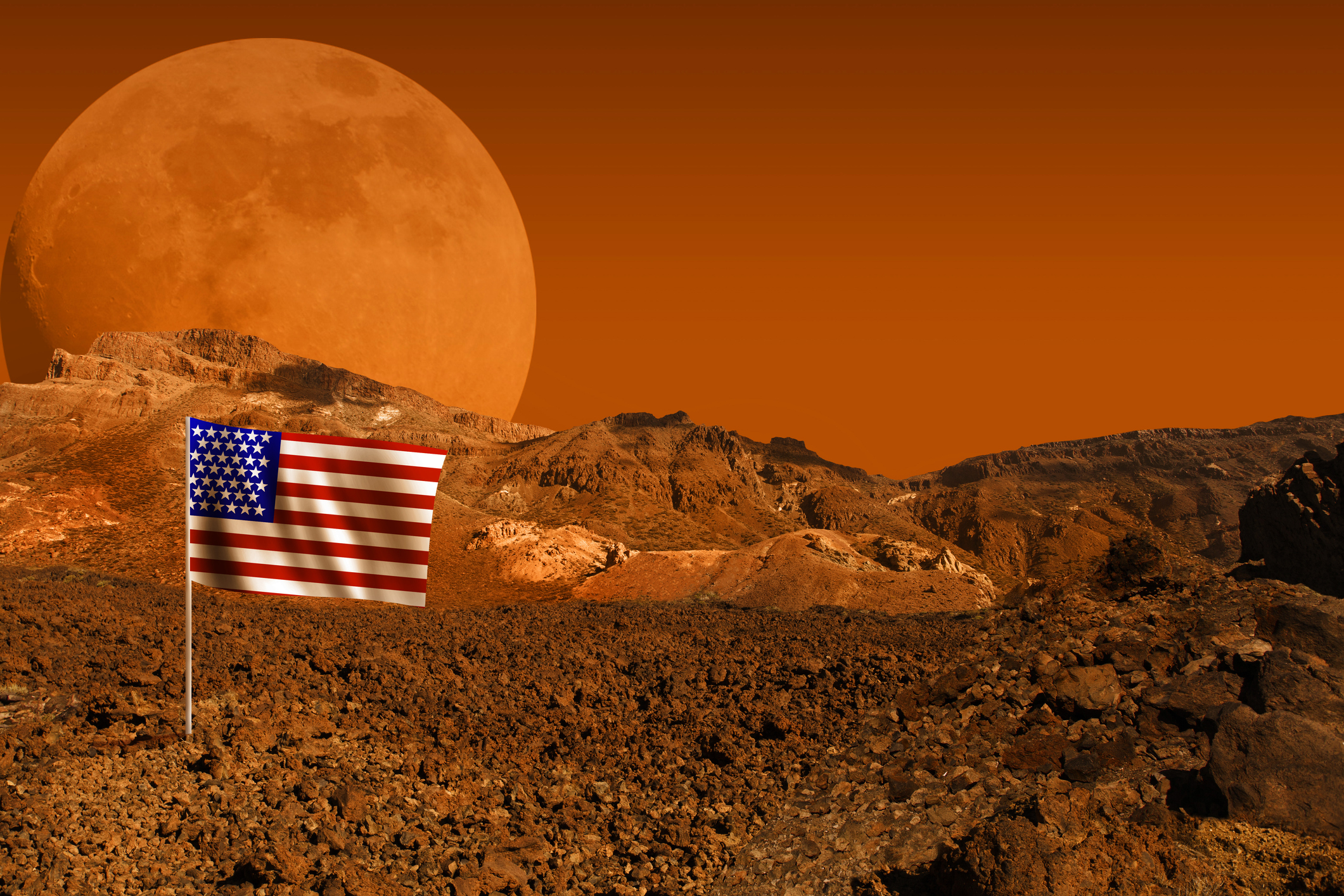Trump wants to colonise Mars – will it happen?
Donald Trump wants to plant the US flag on Mars. Could humans really live there?

Is it possible to colonise Mars?
In 1964, Nasa’s uncrewed Mariner 4 spacecraft made its first successful fly-by of Mars. Then, in July 1976, a craft (Viking 1) made the first successful landing on its surface. In the half-century since, many similar missions have been accomplished, and some have failed. But as yet, no crewed mission has been attempted. Various visionaries have long wanted to change that. The late Stephen Hawking is one. SpaceX’s Elon Musk famously has Mars in his sights. But plenty of sceptics – including eminent astrophysicists such as Martin Rees – believe that, while sending humans to Mars might well be possible, actually living there will be a far bigger challenge.
What’s Mars like?
Mars is the most similar planet to Earth, but there are no seas and almost no water on its surface – just rock and dust. It’s extremely cold and dry, but not as outright impossible to survive on as the other planets, and it was once more watery than it is today.
It turns at almost exactly the same speed as Earth: each day lasts 24 hours and 37 minutes. Mars also has a similar tilting axis and four seasons – but all of them are much colder: the average temperature is -65˚C.
MoneyWeek
Subscribe to MoneyWeek today and get your first six magazine issues absolutely FREE

Sign up to Money Morning
Don't miss the latest investment and personal finances news, market analysis, plus money-saving tips with our free twice-daily newsletter
Don't miss the latest investment and personal finances news, market analysis, plus money-saving tips with our free twice-daily newsletter
The gravitational pull is around 38% of Earth’s, so humans would be able to walk without floating off. Alas, they wouldn’t be able to breathe: the painfully thin atmosphere is 96% carbon dioxide and only 0.13% oxygen (whereas Earth’s is 78% nitrogen and 21% oxygen). Thus, humans on Mars would immediately die without spacesuits and oxygen tanks and would need to live in highly pressurised habitats (atmospheric pressure is just 1% of Earth’s).
How far is Mars from Earth?
Both Mars and Earth have elliptical orbits (Mars’s lasts 687 days) and the distance between them varies greatly. In 2003, Mars got as close to Earth as it’s been for 60,000 years – about 34.8 million miles away. At its farthest, it’s 250 million miles away.
In terms of getting there, or sending robots there, a decent opportunity (when the planets’ orbits are handily aligned) comes around every 26 months. In 1975-1976, Viking 1 took ten months to make the trip, and in 2020-2021 the Perseverance rover took a bit less than seven. Today, Nasa is working towards a nine-month journey, while SpaceX hopes to cut the trip to six months.
Future advances in propulsion methods could conceivably change everything. The most optimistic scientists hope we will develop a photon-propulsion method, using powerful lasers to accelerate spacecraft to near the speed of light – cutting the Mars commute to three days.
Isn’t this all just a pipe dream?
Not all of it. Earlier this year, US president Donald Trump promised Congress that he would “lead humanity into space and plant the American flag on the planet Mars and even far beyond”. He’s wrong, of course: that isn’t going to happen within four years. But it could happen in the next two or three decades, according to both Nasa and SpaceX.
Nasa is officially targeting the “early 2030s” for putting astronauts on Mars’s surface, and is actively working on all aspects of making that possible – including oxygen supply production and supply systems as well as food, water, power (including the use of small nuclear-fission modules), spacesuits, communications and shelter.
In theory, SpaceX is still committed to sending uncrewed test missions to Mars in late 2026 (the next window of opportunity) and the first astronauts in early 2029. In practice, it’s all but certain its Starship rocket system won’t be ready in time. In the longer run, though, most observers think it’s technically possible to land humans on the planet.
Could humans survive on Mars?
That’s a vastly bigger challenge. Mars might have no liquid water on the surface, but there are some big ice glaciers, and there’s believed to be vast amounts of liquid water deep underground.
The optimistic case is that, with plentiful carbon dioxide, it might be possible to grow plants for food and fibre, and make plastics and fuels – including for use as propellants in rocket ships.
Moreover, says Robert Zubrin on UnHerd, Martian water is five times as rich as terrestrial water in deuterium, which is the fuel for nuclear-fusion reactors. Once fusion power is mastered, Mars will potentially “offer infinite energy, allowing its settlers to transform its mineral wealth into steel, pipes, greenhouses, and cities.
It will eventually become the natural take-off point for expeditions to mine the precious metal riches of the asteroid belt”. For that to happen, terraforming will be needed.
What is terraforming?
Making a planet more like Earth, by intentionally modifying its atmosphere, temperature, surface topography and ecology.
The notion is a common theme in science fiction, but whether future technological advances might make it feasible (or morally justifiable) in real life is fiercely contested. In Mars’s case, in addition to the challenges already discussed, humans would have to deal with global dust storms and the lack of a global magnetic field to shield against vastly higher levels of solar and other cosmic radiation.
Mars’s surface is covered with toxic perchlorates, making the planet’s “soil” hard to farm. Proponents of terraforming think that the emerging field of synthetic biology – the use of genetic engineering and other advances in biotechnology to generate new organisms or manipulate existing ones – might help us detoxify Mars and let us grow food there.
How might humans adapt to Mars?
Rees argues that, to survive on Mars, human settlers may need to redesign themselves to adapt to the alien environment, harnessing the genetic and cyborg technologies that might be invented in coming decades.
Ultimately, the necessary adaptations might be “the first divergence into a new species”, he reckons – and even a transition to “inorganic intelligences” and “non-biological brains”.
In other words, colonising the red planet may not just be about terraforming but also about “Marsforming” humanity. Watch this space.
This article was first published in MoneyWeek's magazine. Enjoy exclusive early access to news, opinion and analysis from our team of financial experts with a MoneyWeek subscription.
Get the latest financial news, insights and expert analysis from our award-winning MoneyWeek team, to help you understand what really matters when it comes to your finances.
Simon Wilson’s first career was in book publishing, as an economics editor at Routledge, and as a publisher of non-fiction at Random House, specialising in popular business and management books. While there, he published Customers.com, a bestselling classic of the early days of e-commerce, and The Money or Your Life: Reuniting Work and Joy, an inspirational book that helped inspire its publisher towards a post-corporate, portfolio life.
Since 2001, he has been a writer for MoneyWeek, a financial copywriter, and a long-time contributing editor at The Week. Simon also works as an actor and corporate trainer; current and past clients include investment banks, the Bank of England, the UK government, several Magic Circle law firms and all of the Big Four accountancy firms. He has a degree in languages (German and Spanish) and social and political sciences from the University of Cambridge.
-
 Why Trustpilot is a stock to watch for e-commerce exposure
Why Trustpilot is a stock to watch for e-commerce exposureTrustpilot has built a defensible position in one of the most critical areas of the internet: the infrastructure of trust, says Jamie Ward
-
 Tetragon Financial: An investment trust with stellar returns
Tetragon Financial: An investment trust with stellar returnsTetragon Financial has performed very well, but it won't appeal to most investors – there are clear reasons for the huge discount, says Rupert Hargreaves
-
 How to capitalise on the pessimism around Britain's stock market
How to capitalise on the pessimism around Britain's stock marketOpinion There was little in the Budget to prop up Britain's stock market, but opportunities are hiding in plain sight. Investors should take advantage while they can
-
 London claims victory in the Brexit wars
London claims victory in the Brexit warsOpinion JPMorgan Chase's decision to build a new headquarters in London is a huge vote of confidence and a sign that the City will remain Europe's key financial hub
-
 Reinventing the high street – how to invest in the retailers driving the change
Reinventing the high street – how to invest in the retailers driving the changeThe high street brands that can make shopping and leisure an enjoyable experience will thrive, says Maryam Cockar
-
 The consequences of the Autumn Budget – and what it means for the UK economy
The consequences of the Autumn Budget – and what it means for the UK economyOpinion A directionless and floundering government has ducked the hard choices at the Autumn Budget, says Simon Wilson
-
 The global defence boom has moved beyond Europe – here’s how to profit
The global defence boom has moved beyond Europe – here’s how to profitOpinion Tom Bailey, head of research for the Future of Defence Indo-Pac ex-China UCITS ETF, picks three defence stocks where he'd put his money
-
 Profit from a return to the office with Workspace
Profit from a return to the office with WorkspaceWorkspace is an unloved play on the real estate investment trust sector as demand for flexible office space rises
-
 An “existential crisis” for investment trusts? We’ve heard it all before in the 70s
An “existential crisis” for investment trusts? We’ve heard it all before in the 70sOpinion Those fearing for the future of investment trusts should remember what happened 50 years ago, says Max King
-
 No peace dividend in Trump's Ukraine plan
No peace dividend in Trump's Ukraine planOpinion An end to fighting in Ukraine will hurt defence shares in the short term, but the boom is likely to continue given US isolationism, says Matthew Lynn